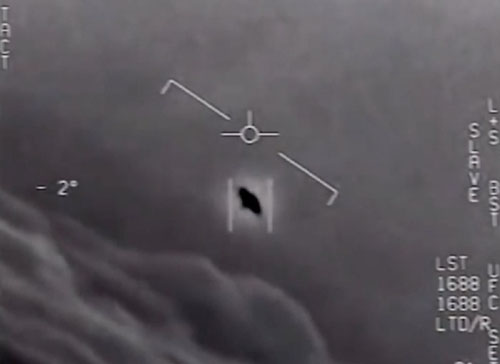by WorldTribune Staff, May 21, 2019
“Situational awareness” is the military term for having complete understanding of the environment in which you are operating.
“During a military mission, whether in peace or in war, if a pilot or soldier can’t identify an object, they have a serious problem: How should they react, without knowing if it is neutral, friendly or threatening?” asked Iain Boyd, Professor of Aerospace Engineering at the University of Michigan, in a May 21 analysis.

Fortunately, Boyd said, “the military can use advanced technologies to try to identify strange things in the sky.”
New Pentagon rules encourage U.S. Navy pilots and sailors to keep track of what they see. Under the policy, Navy personnel “won’t be considered crazy for reporting unidentified flying objects,” Boyd noted.
A few years ago, the Pentagon reportedly shut down an official program that investigated UFO sightings after decades of official secrecy on the subject.
“What has changed?” Boyd asked, adding, “Is the U.S. military finally coming around to the idea that alien spacecraft are visiting our planet?”
The answer to that question, Boyd said in less-than-definitive terms, “is almost certainly no.”
Related: Leaked report details days-long, high-speed UFO incidents near Nimitz carrier group, May 27, 2018
Boyd continued: “Humans’ misinterpretation of observations of natural phenomena are as old as time and include examples such as manatees being seen as mermaids and driftwood in a Scottish loch being interpreted as a monster. A more recent and relevant example is the strange luminescent structure in the sky caused by a SpaceX rocket launch. In these types of cases, incorrect interpretations occur because people have incomplete information or misunderstand what they’re seeing.”
Boyd said that, based on his experience as a science advisor to the Air Force, he believes the Pentagon “wants to avoid this type of confusion, so it needs to better understand flying objects that it can’t now identify.”
Globally, the number of UFO reportings in a year has peaked at more than 8,000. It’s not known how many the military experiences.
“Even the most heavily documented incidents end up unresolved, despite interviewing dozens of witnesses and reviewing many written documents, as well as lots of audio and video recordings,” Boyd noted.
“UFOs represent an opportunity for the military to improve its identification processes,” Boyd wrote.
In the future, sensors could well handle those processes, the professor said.
“Sensors can provide a wealth of information on UFOs including range, speed, heading, shape, size and temperature. With so many sensors and so much data, though, it is a challenge to merge the information into something useful. However, the military is stepping up its work on autonomy and artificial intelligence. One possible use of these new technologies could be to combine them to analyze all the many signals as they come in from sensors, separating any observations that it can’t identify. In those cases, the system could even assign sensors on nearby vehicles or orbiting satellites to collect additional information in real time. Then it could assemble an even more complete picture.”
The Navy’s new approach to reporting UFO encounters “is a good first step,” Boyd wrote. “This may eventually lead to a comprehensive, fully integrated approach for object identification involving the fusion of data from many sensors through the application of artificial intelligence and autonomy. Only then will there be fewer and fewer UFOs in the sky — because they won’t be unidentified anymore.”
Your Intel Brief: Geostrategy-Direct __________ Fix The Media Now
